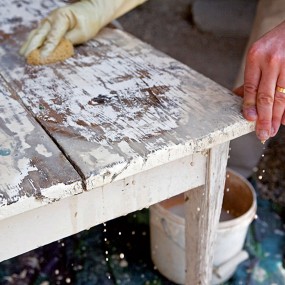<Previous

Choose the right stripper
Most stripping products work well on just about any type of finish. So, when you’re shopping for one, it really comes down to two factors: speed and safety. Don’t blindly accept marketing claims on the front of the bottle about how safe it is. Some ‘safe’ strippers contain chemicals that are dangerous if you touch them with bare hands or inhale the fumes. Read the back of the bottle! That’s where you’ll find information about what chemicals it contains and what safety precautions you should take.
Strip Safely
Most stripping products require the use of eye, skin and lung protection. Wear splash-proof goggles, long sleeves and pants, chemical-resistant gloves and a respirator with new organic vapor cartridges. Keep a bucket of water with rags handy to wipe off stripper that gets on your skin. Work outside if at all possible. If you must work indoors, open as many windows and doors as you can.
Metal container/Disposable brush
Because some strippers eat plastic, manufacturers recommend pouring their products into a metal container, even though some are sold in plastic containers. Use a foil pan, a paint can or an old coffee can.
Use a disposable chip brush or an old paintbrush that you don’t care about. When finished, allow the brush to dry completely and throw it into the trash.
Carpet your workbench
A piece of used carpeting or a new carpet remnant on a table or workbench makes a great surface for stripping furniture. The soft carpet protects wood from nicks and scratches and also absorbs drips. You can also use a tarp, plastic drop cloth or old newspapers.
Brush it on thick
Many strippers go on like a gel, so don’t be afraid to get it on thick—1/8 in. to 1/4 in. Add a second coat if the first one dries before you have time to scrape it off, or if the finish doesn’t all come off the first time.
Strip in zones
When stripping a really large piece of furniture, do it in ‘zones.’ Only apply stripper to part of the piece and scrape it off before the stripper dries.
Use a box
A small cardboard box works great for cleaning off your putty knife. Let the stripper residue in the box dry completely before disposing of it in the trash.
Is it worth stripping?
Sometimes a piece of painted furniture is painted because somebody tried to hide something like a repair, ugly wood or finger-jointed boards. Try stripping a small area to see what’s under all that paint before committing to doing the whole thing.
Don’t bother stripping furniture you plan to paint
If you’re going to paint (or repaint) a piece of furniture, you probably don’t need to strip it. Wash it with TSP substitute mixed with water. Then, using medium- or fine-grit sandpaper, smooth out any bumps or flaking paint and scuff-sand other areas so the new paint will stick better. This applies to painting over clear finishes as well.
https://www.familyhandyman.com/woodworking/furniture-repair/stripping-furniture-tips-for-refinishing/
How to strip antique furniture

Choose the right stripper
Most stripping products work well on just about any type of finish. So, when you’re shopping for one, it really comes down to two factors: speed and safety. Don’t blindly accept marketing claims on the front of the bottle about how safe it is. Some ‘safe’ strippers contain chemicals that are dangerous if you touch them with bare hands or inhale the fumes. Read the back of the bottle! That’s where you’ll find information about what chemicals it contains and what safety precautions you should take.
Strip Safely
Most stripping products require the use of eye, skin and lung protection. Wear splash-proof goggles, long sleeves and pants, chemical-resistant gloves and a respirator with new organic vapor cartridges. Keep a bucket of water with rags handy to wipe off stripper that gets on your skin. Work outside if at all possible. If you must work indoors, open as many windows and doors as you can.
Metal container/Disposable brush
Because some strippers eat plastic, manufacturers recommend pouring their products into a metal container, even though some are sold in plastic containers. Use a foil pan, a paint can or an old coffee can.
Use a disposable chip brush or an old paintbrush that you don’t care about. When finished, allow the brush to dry completely and throw it into the trash.
Carpet your workbench
A piece of used carpeting or a new carpet remnant on a table or workbench makes a great surface for stripping furniture. The soft carpet protects wood from nicks and scratches and also absorbs drips. You can also use a tarp, plastic drop cloth or old newspapers.
Brush it on thick
Many strippers go on like a gel, so don’t be afraid to get it on thick—1/8 in. to 1/4 in. Add a second coat if the first one dries before you have time to scrape it off, or if the finish doesn’t all come off the first time.
Strip in zones
When stripping a really large piece of furniture, do it in ‘zones.’ Only apply stripper to part of the piece and scrape it off before the stripper dries.
Use a box
A small cardboard box works great for cleaning off your putty knife. Let the stripper residue in the box dry completely before disposing of it in the trash.
Is it worth stripping?
Sometimes a piece of painted furniture is painted because somebody tried to hide something like a repair, ugly wood or finger-jointed boards. Try stripping a small area to see what’s under all that paint before committing to doing the whole thing.
Don’t bother stripping furniture you plan to paint
If you’re going to paint (or repaint) a piece of furniture, you probably don’t need to strip it. Wash it with TSP substitute mixed with water. Then, using medium- or fine-grit sandpaper, smooth out any bumps or flaking paint and scuff-sand other areas so the new paint will stick better. This applies to painting over clear finishes as well.
https://www.familyhandyman.com/woodworking/furniture-repair/stripping-furniture-tips-for-refinishing/



